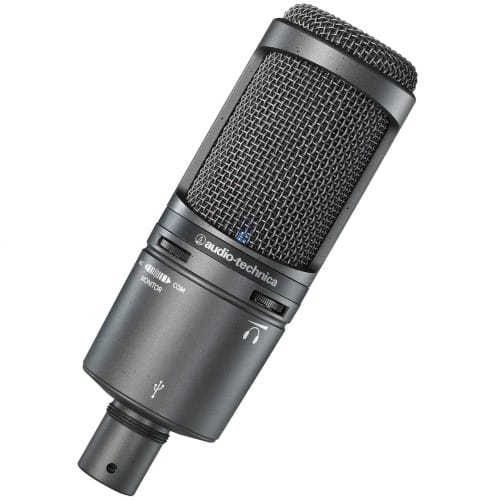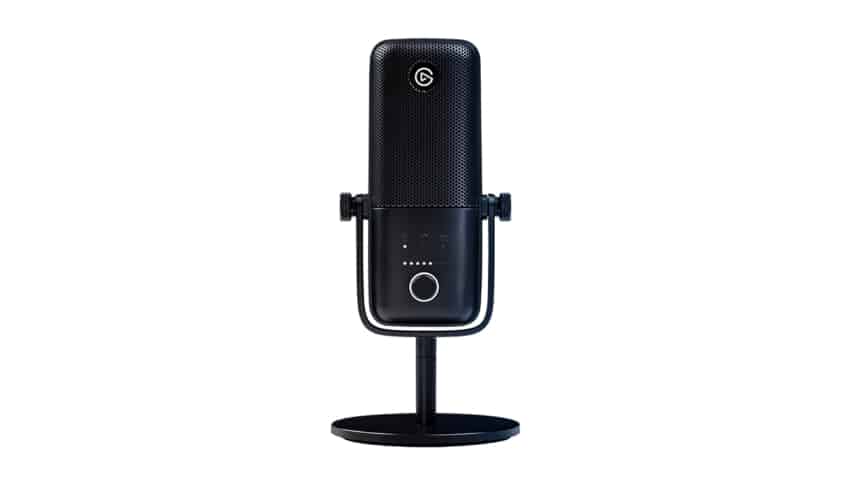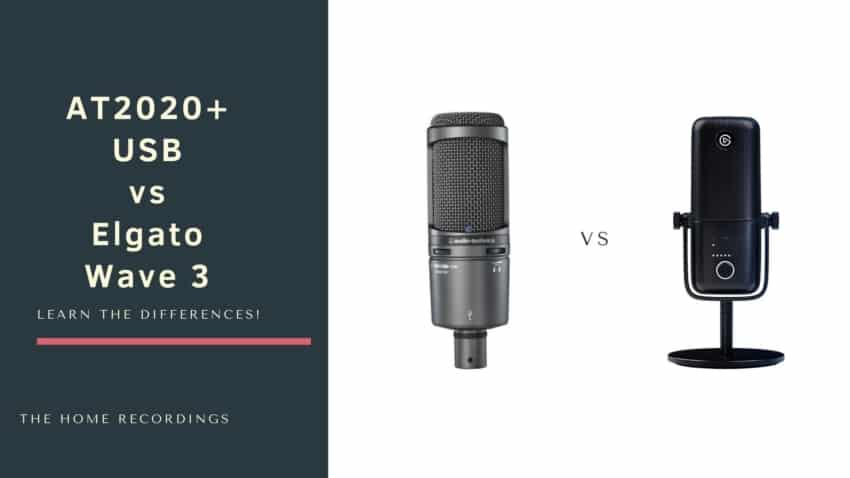Last updated on December 29th, 2023 at 09:57 pm
The AT2020 has been a staple in the music industry for year now, and the USB version is just as good with the added benefit of not needing an Audio Interface to work.
However, nowadays there are many more USB microphones to choose from, one of which is the ElGato Wave 3, considered by many to be the best Gaming/Streaming microphone available today.
In this post I will compare the two, both in terms of their overall features as well as performance, and give you my honest opinion on which one you should get depending on your needs.
So, let’s get started with the differences between the two;
AT2020+ USB Vs ElGato Wave 3
The AT2020 USB has a better overall build quality and a brighter top-end than the Wave 3. On the other hand, the Wave 3 features a Clipguard as well as a High-Pass filter and the Wavelink software that allows you to mix different audio sources for streaming.
Ok, let’s kick things off with an overview of the AT2020+ USB.
Audio-Technica AT2020+ USB

There are few better-known brands in the music industry than Audio-Technica.
They make some of the best microphones available on the market and the AT2020 is the go-to mic for almost every beginner home recording enthusiast, plus you won’t see a studio that doesn’t have at least a couple of them.
The USB version of the Audio-Technica AT2020 is just as good as the XLR AT2020 with the advantage of being a plug n’ play microphone that works both on Windows and Mac OS without the need of installing any sort of driver.
It comes with a built-in headphone jack and a volume control that allows you to directly monitor what is being recorded with no delay (Zero latency).
It also offers a mix control that blends the microphone and the pre-recorded audio.
The controls on the AT2020 aren’t as easy to use as I would have liked, and this is something that is definitely easier to do on the ElGato Wave 3.
One thing I like about the AT2020 is that it’s small and lightweight, which makes it an excellent microphone for travelling and recording on the go.
Just like all the Audio-Technica microphones, the AT2020+ is extremely well built.
When holding it in my hand it doesn’t feel like a cheap product at all, quite the opposite actually.
Lastly, the AT2020+ can be used for anything voice related, recording music, YouTube videos, etc.
How does it Perform?
Since the AT2020 is a plug n’ play microphone, you should have absolutely no issues getting it to work; simply connect it and that’s it, you can now record!
The sound quality is excellent, and I mean excellent, especially considering the price, since you probably won’t find another USB microphone at this price range that sounds this good.
The only thing I don’t like that much is that it can sound a bit crispy at times, but that isn’t that much of an issue really since you can fix that with just a bit of EQ afterwards.
I often refer to the AT2020+ as my top recommendation for anyone who is looking for a cardioid condenser USB microphone simply because of the overall sound quality.
It records vocals extremely well, and I believe that recording voice-related audio is where this microphone really shines.
Of course, it can be used for recording acoustic and classical guitars as well, which is what I used it for before getting some of the other microphones I own.
One big con though is that when recording an overdriven electric guitar it may take you a while to fine-tune the tone, find the correct mic position, etc.
And this is an issue that I had, since it took me over 10 min to get a decent tone out of it, and I still didn’t quite like it.
Everything else, sounded fantastic!
There’s a reason why the AT2020 (XLR Version) is part of almost every music studio, and that is because when taking cost-effectiveness into account, there are few microphones that can stand up to it.
The USB version is just as good, just a bit more expensive… But it doesn’t require you to purchase a separate audio interface!
Related: Here’s a post where I compare the Blue Yeti to the AT2020+, should you be interested.
What do you get in the Box?
- The Audio-Technica AT2020+ USB microphone
- Tripod desk stand
- USB cable
- Storage Pouch
Features
- Headphone Output with volume control
- Tripod desk stand and USB cable included
- Mac and PC Compatible
- Built-in headphone jack
- Mix and Volume Control
Specifications
- Polar Pattern: Cardioid
- Frequency Response: 20Hz- 20kHz
- Sample Rate: 44.1kHz – 48kHz/16-bit
- Weight: 386g
Find out more about the AT2020 USB here: Amazon, Sweetwater, Guitar Center.
Elgato Wave 3

Now, I have to say that I didn’t have high expectations for this mic at all, but I definitely was impressed since for once a company decided to focus on what the users actually need, instead of just adding unnecessary features to inflate the price.
So, if you’re a gamer, YouTuber, Streamer, etc., this microphones probably has everything you need.
As far as the build quality goes, it’s nothing to brag about since the body is made out of plastic which does feel a little cheap, and the U-bracket that attaches the mic to the desk-stand is also made of plastic.
The mesh grille is metal, but it has a bit of give to it, which isn’t ideal as well.
Even though it should last you a very long time if taken good care of, the overall build quality is lacking, and I wouldn’t recommend dropping this mic or anything similar.
However, and even despite this, I still think that it’s probably the best microphone for Gamers/YouTubers out there, and here are the reasons for that:
- It features a “Clipguard”, which when enabled will prevent clipping or saturation if you signal gets too loud; like for example if you scream.
- It also comes with a high-pass filter that can be enabled to remove a bit of the low end, and this can come in handy when you want to better deal with the proximity effect (basically, the closer you get to the mic, the more low-end you will hear, and the high-pass filter helps deal with this).
These features can be accessed through the Wave Link software that comes with the mic and are definitely something that the gaming and streaming community desperately need to be able to produce content with good sound quality, and it’s refreshing to see that a company has finally taken notice.
Of course, this is very intentional since the Elgato Wave 3 was designed with gaming and streaming in mind, where extra microphone patterns really don’t serve any purpose.

Lastly, it features a Mute button, gain control, headphone volume, and the mix control between the computer’s playback and zero-latency monitoring.
Note: If you want to check out my full written review of the ElGato Wave 3, you can find it here.
How does it perform?
As far as spoken word goes, which is what this mic was mainly designed for, it’s absolutely great since there are no prominent frequencies poking there head out anywhere, plus if you want to get rid of some of the low end, you can always engage the high pass filter.
The Clip Guard is definitely a huge plus here, since there will be no more clipping/distorting, which is definitely something that streamers have to del with on a daily basis.
There is one issue though, and it’s that the desk stand doesn’t really help reject any noise coming from the desk itself, like for example if you tap your fingers on it, the vibration coming from the keyboard, or basically bumping against the desk.
In that case, I would much rather recommend a boom arm with a shock mount to absorb those vibrations.
Now, what if you want to record music with it?
Well, for singing it does more than fine!
As far as recording instruments go, it did a decent job at recording acoustic guitar, and the HPF came in handy here since it allowed me to angle it more towards the sound hole and still get a good recording.
Also, I have to say that I was pleasantly surprised at how well it managed to capture the sound of my electric guitar cabinet, even with distortion.
Still, I think that I would much rather use a good dynamic mic for this, but hey… it works!
Finally, the Wave Link software that comes with this microphone is where you can enable the Clip Guard and the High Pass filter, plus it lets you mix the audio signals from different sources in the PC, like Google Chrome, etc. and decide how high or low the volume of every source will be on the stream.
What comes in the Box?
- Elgato Wave 3 Microphone
- USB Cable
- Mic Stand adapter
Features
- ClipGuard
- High Pass Filter
- Mute Button
- Wave Link Software for more in-depth control of the audio
Specifications
- Polar Pattern; Cardioid
- Frequency Response: 20Hz- 20kHz
- Sample Rate: 48kHz/96kHz – 24-bit
- Max SPL: 120dB
- Sensitivity: -25dBFS
- Weight: 280g
Which one should you get?
I personally prefer the AT2020+ USB, but mainly because I would be using it to record music.
But which one YOU should get depends entirely on your needs, since one isn’t better than the other overall.
For gaming and streaming, absolutely go with the Wave 3 since it’s designed to do that, and having the ClipGuard and the Wavelink software will make your life a lot easier.
On the other hand, if you’re not worried about clipping the audio, in other words recording too loud of a signal, then the AT2020 USB would be a better choice.
Still, the difference in sound quality aren’t as big as one would expect since both microphones do very well at recording spoken word, singing, an instruments.
Conclusion
Both the AT2020 USB and the Wave 3 sell for a very similar price and the overall audio quality is fairly similar.
The only reason to choose between one and the other is depending on your needs; Are you a gamer or streamer? Then go with the Wave 3.
Are you a musician? Then go with the AT2020 USB.
I hope this information was useful.
Have a great day!

thank you very much.this is very helpful for me.